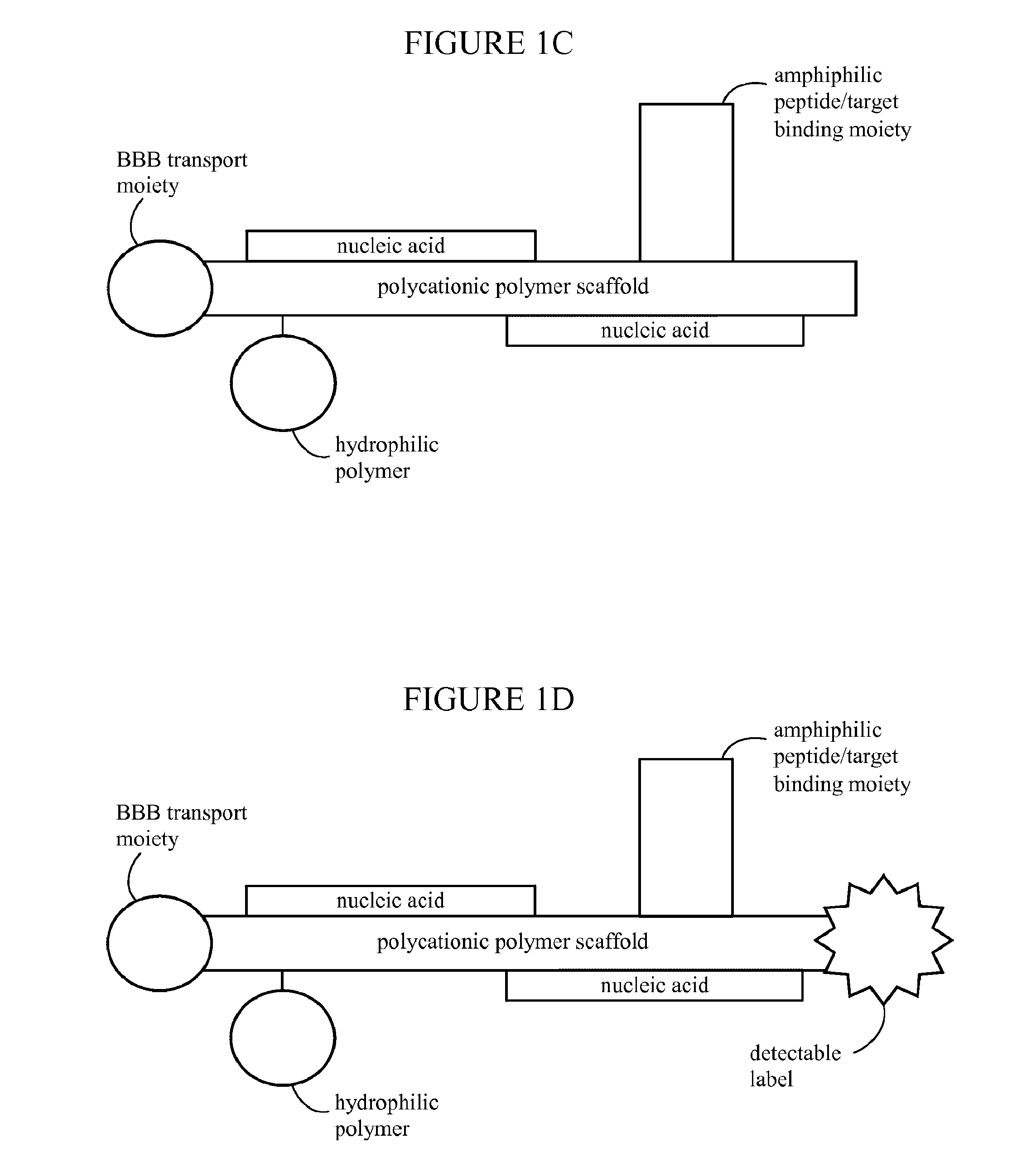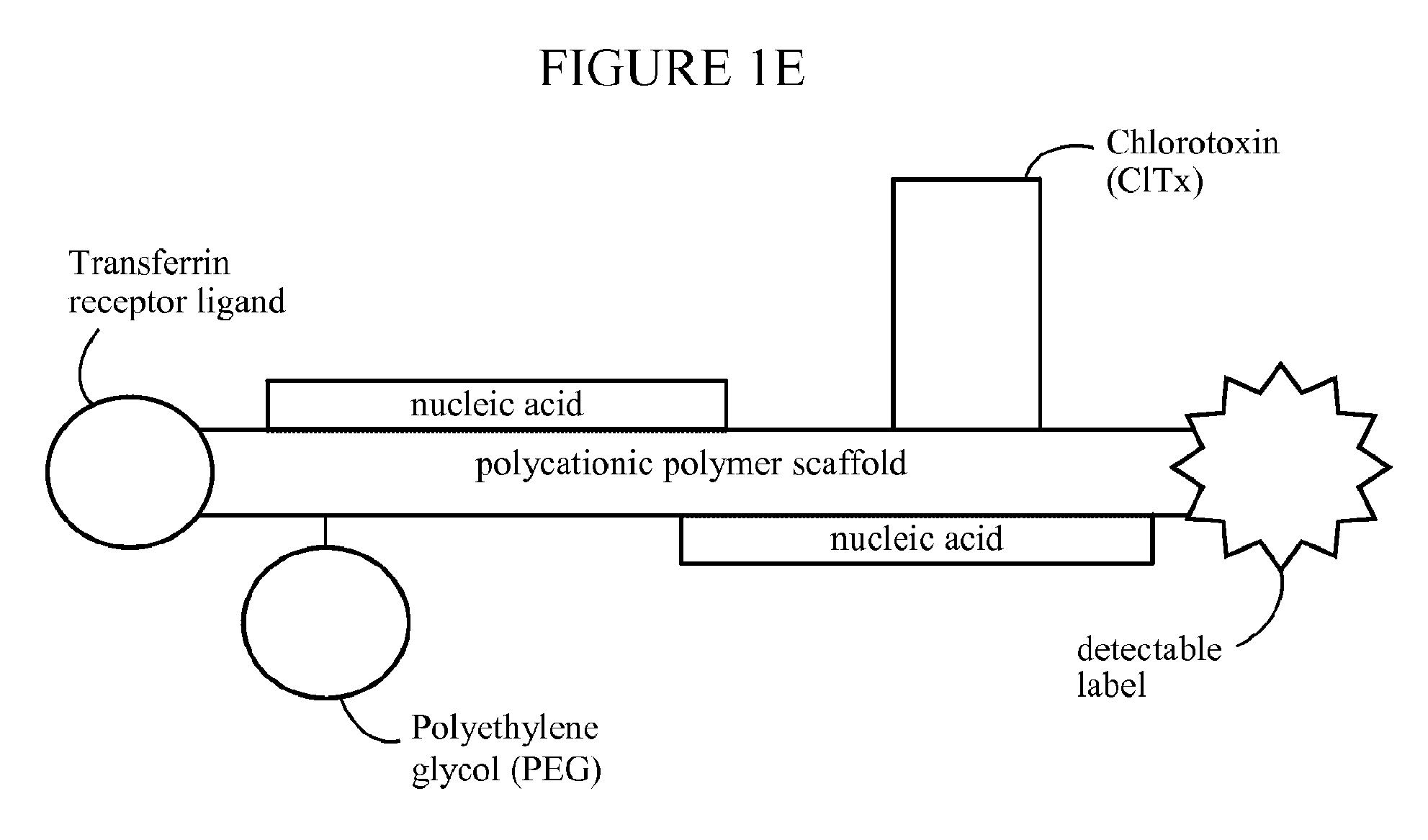Nanoparticles for targeted gene therapy and methods of use thereof
a gene therapy and nanoparticle technology, applied in the direction of nanocapsules, biochemistry apparatus and processes, capsule delivery, etc., can solve the problems of difficult clinical application, high toxicity, and the gbm remains a lethal cancer, and achieve the effect of facilitating delivery
- Summary
- Abstract
- Description
- Claims
- Application Information
AI Technical Summary
Benefits of technology
Problems solved by technology
Method used
Image
Examples
example 1
Preparation of Polymeric Nanoparticles
[0522]Polymeric nanoparticles including siRNA or plasmids capable of expressing shRNA were prepared as follows: Generally, the synthetic polymeric polycation (poly-lysine (PL235), Mw=38 kDa) was covalently conjugated with N-terminal modified Transferrin (Tf), a ligand binding to transferrin cell surface receptor, and the conjugate was purified by column fractionation forming Tf-PL235. Each polymeric polycation (PL235) molecule carried 1-2 subunits of receptor ligand. The same polymeric polycation was also covalently conjugated to 1-5 molecules of modified Chlorotoxin peptide (MCP). The fractionated Tf-PL235 was successively thiolated by PDP activation and purified by size exclusion chromatography (SEC). Following quantification of the degree of modification, Tf-PL235-SH was reacted with thiolated ClTx (MCMPCFTTDHQMARKCDDCCGGKGRGKCYGPQCLCR) or a random 36-aa peptide (RP). Purified thiolated Tf-PL235 also were covalently conjugated to PEG (Mw=5000...
example 2
In-Vitro Delivery to Primary GBM Cells
[0537]Stabilized and targeted ClTx-Cy5.5-ClTx-Tf-PEG-PL235 / pGFP-based nanoparticles were prepared generally as described above with the exception that plasmid DNA encoding green fluorescent protein (GFP) was included as the nucleic acid.
[0538]Materials and Methods:
[0539]Several NP with different attributes and conjugate stoichiometries were designed to express eGFP gene carried on a mammalian expression plasmid, where the eGFP expression was driven by hCMV promoter / enhancer. The formulated nanoparticles included conjugated tissue targeting surface markers such as ClTx and Tf, and covalently attached PEG5000 for in vivo stability. Stoichiometric ratios of surface moieties and scaffolds optimized for delivery of GFP plasmid DNA and siRNA were tested in vitro. An optimized formulation is detailed above (see description of NP formulation) where each monomer (i.e., NP polymer scaffold subunit) contained a PL235 polymeric lysine scaffold covalently bo...
example 3
In-Vivo Delivery of Interfering RNA to GBM Cells
[0542]GBM cultures enriched in glioma stem like cells (referred to as GSC1 and GSC2) which express Id-1 and can recapitulate the disease in vivo when intracranially implanted in nude mice were used to test interfering RNA containing nanoparticles in vivo.
[0543]Materials and Methods:
[0544]Primary GBM tissues were sorted for stem cell markers and cultured in neurosphere conditions. FIG. 3, Panel A, left, provides a phase photomicrograph of the cultures. FIG. 3, Panel A, right, shows results for the immunofluorescent detection of Nestin and CD133 (two stem cell markers). Immuno-fluorescence analysis of primary GSC cells showed they were positive for Id-1 (FIG. 3, Panel B, middle) and nestin (FIG. 3, Panel B, right). The results for control IgG are shown in FIG. 3, Panel B, left. Cells were counterstained with DAPI.
[0545]An in vivo GBM mouse model was produced by intracranial injection of GSC1 and GSC2 cells. The cells were modified to exp...
PUM
| Property | Measurement | Unit |
|---|---|---|
| time | aaaaa | aaaaa |
| dissociation constant | aaaaa | aaaaa |
| dissociation constant | aaaaa | aaaaa |
Abstract
Description
Claims
Application Information
 Login to View More
Login to View More - R&D
- Intellectual Property
- Life Sciences
- Materials
- Tech Scout
- Unparalleled Data Quality
- Higher Quality Content
- 60% Fewer Hallucinations
Browse by: Latest US Patents, China's latest patents, Technical Efficacy Thesaurus, Application Domain, Technology Topic, Popular Technical Reports.
© 2025 PatSnap. All rights reserved.Legal|Privacy policy|Modern Slavery Act Transparency Statement|Sitemap|About US| Contact US: help@patsnap.com



